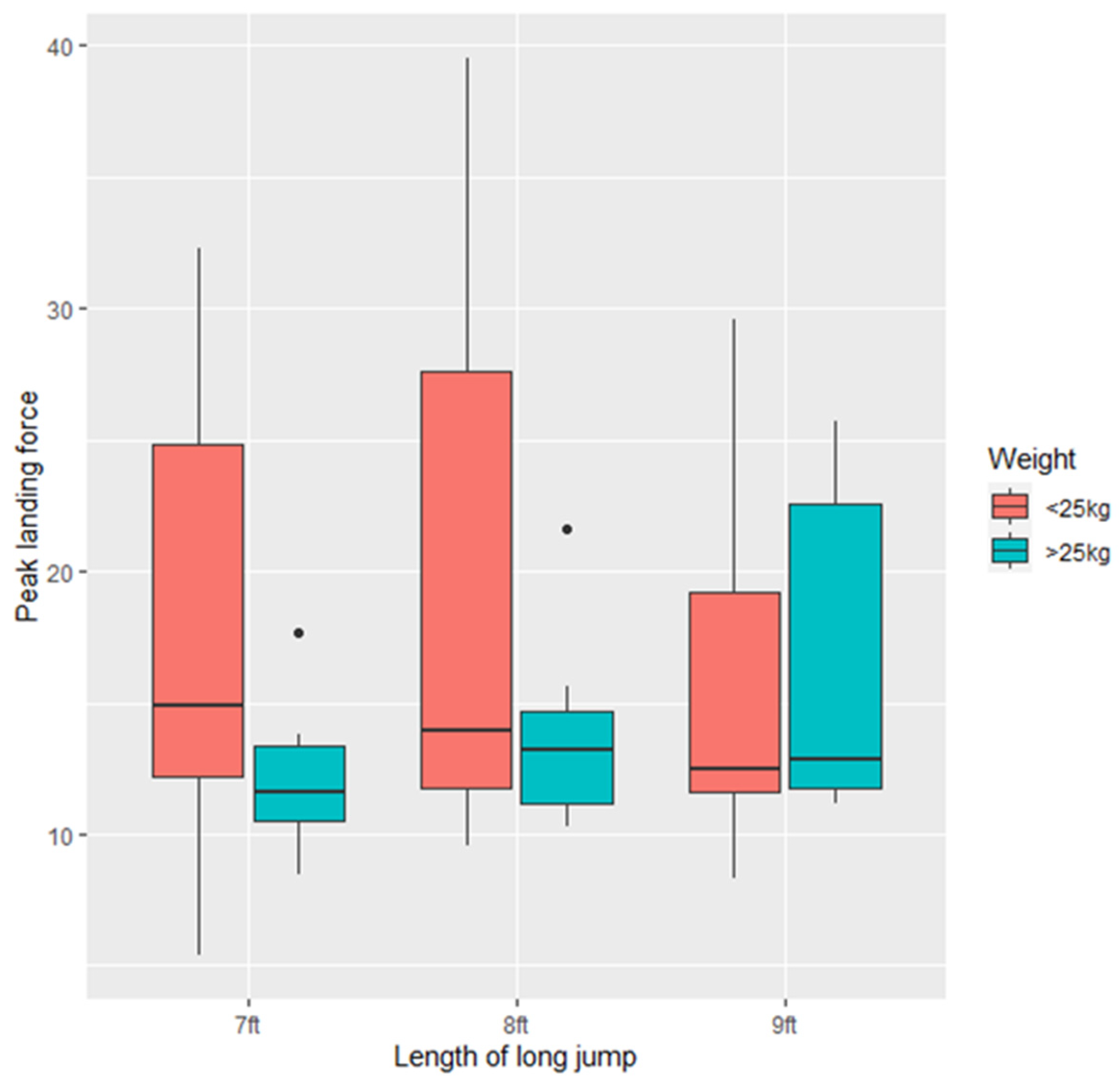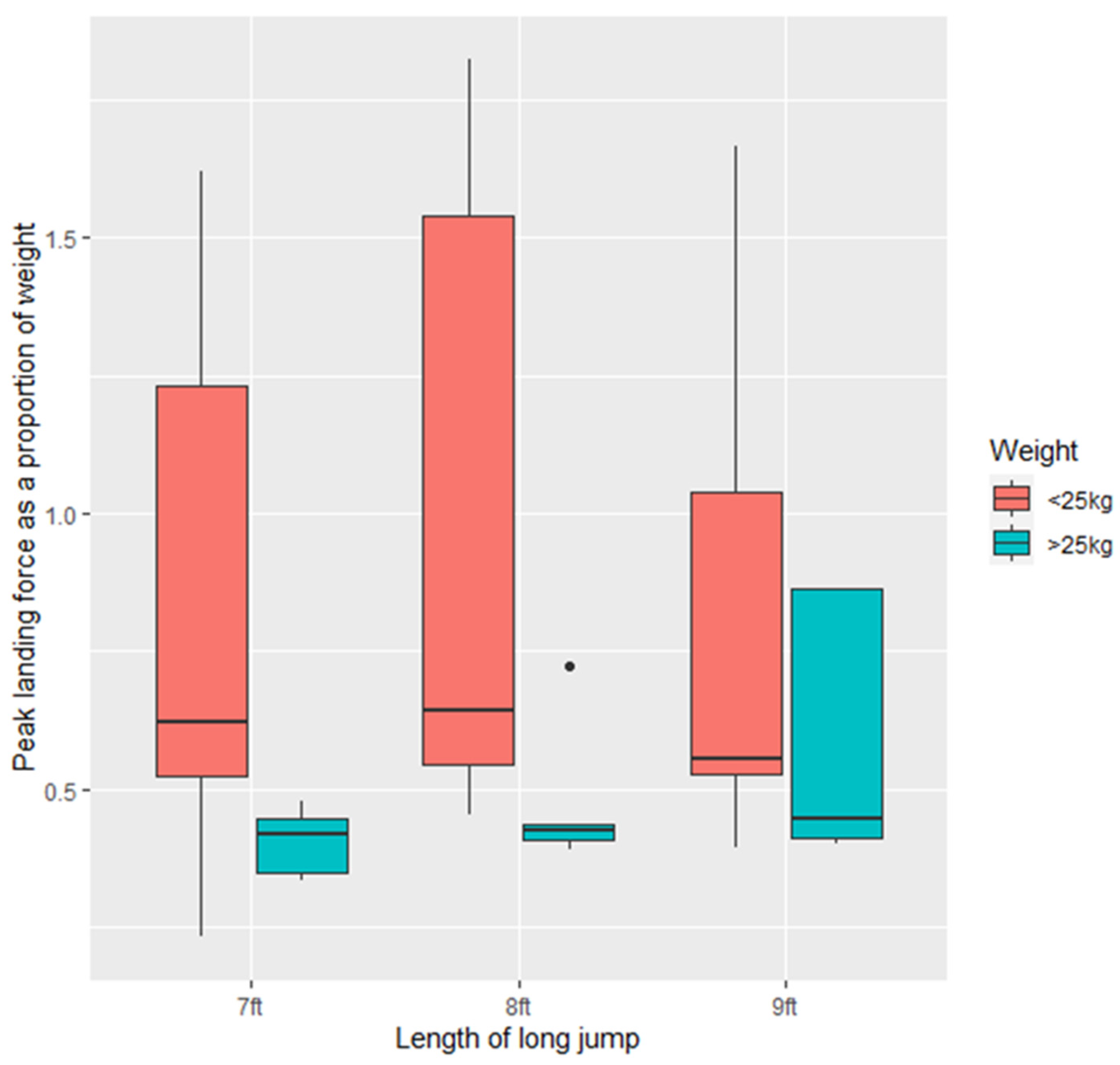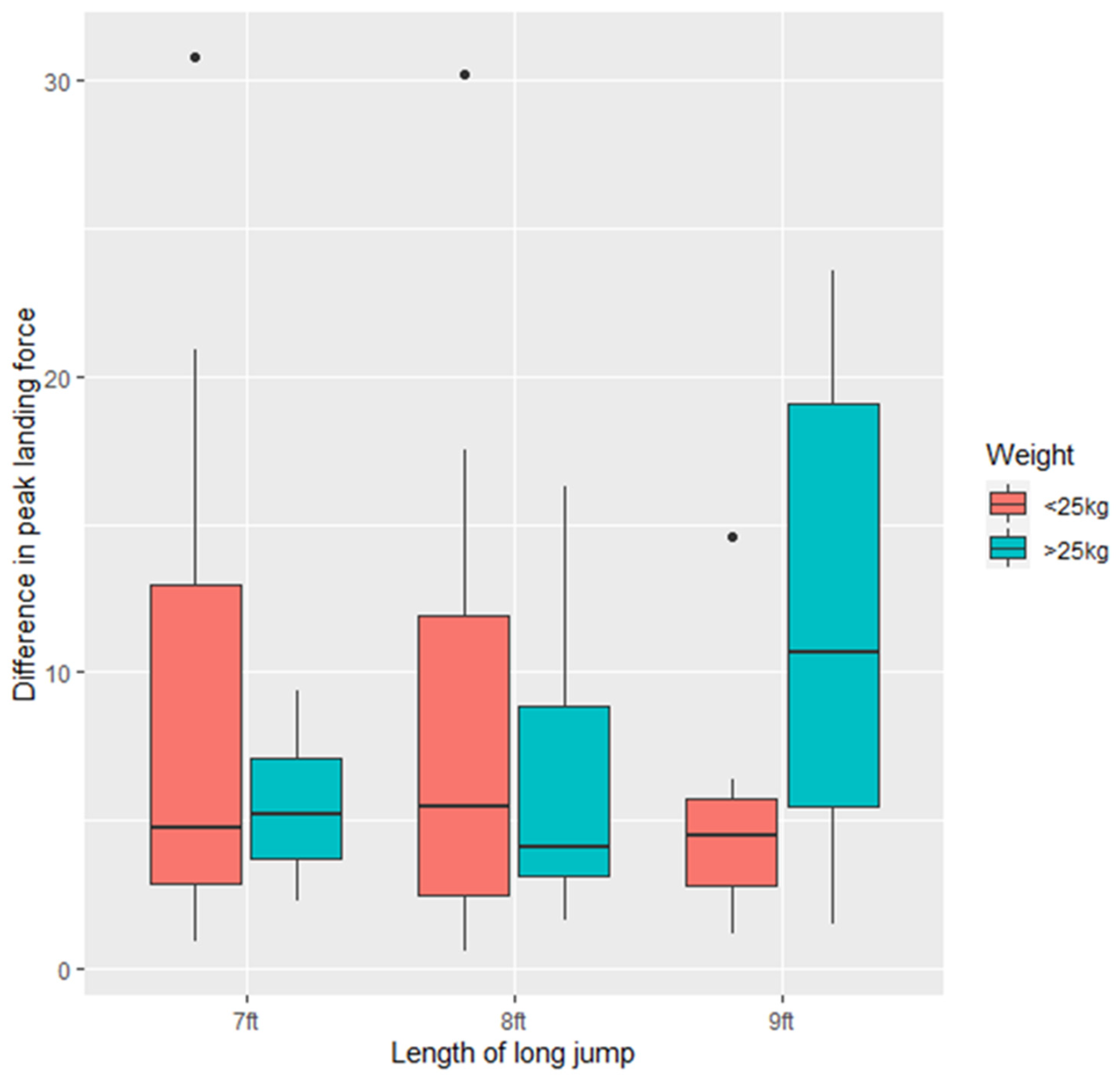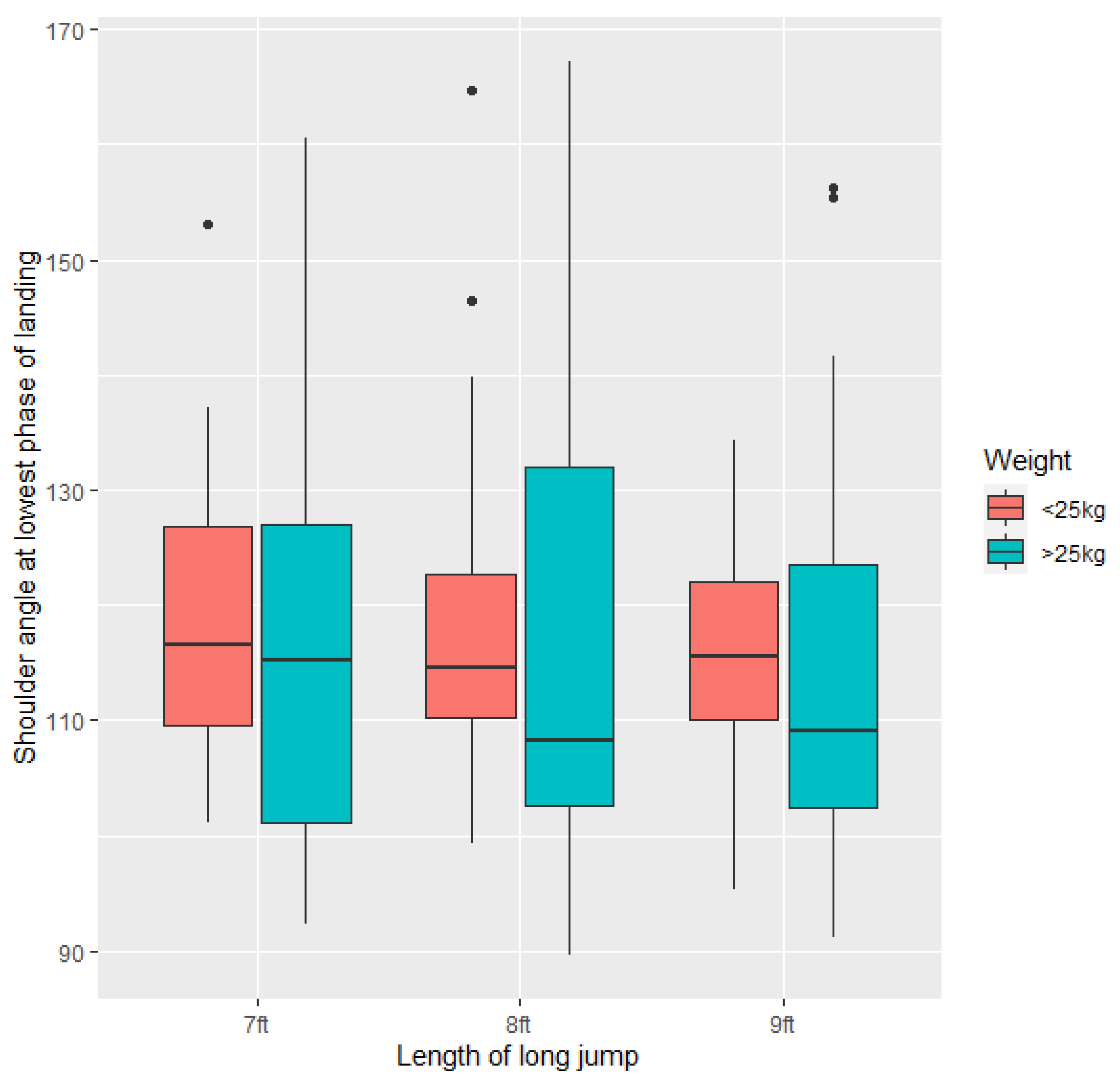1. Introduction
Working trials originated as a competitive canine discipline in the 1920s, based on tasks required by military and police dog work. Working trials competitions require dogs to complete three components: scent work, agility (clearing a 6 ft scale (wall), 9 ft long jump and a 3 ft hurdle, all ‘under control’), and ‘control’ obedience tasks [
1]. The long jump consists of five sections, no less than 3 ft (91 cm) wide, of increasing width and height, from 4 inches (101.6 mm) high rising to 7 inches (177.8 mm) at the rear edge. The total distance of the long jump is 9 ft (274 cm). By comparison, the long jump in Kennel Club (KC) agility competition consists of three to five sections, with an overall length of between 1.2 m and 1.5 m for large dogs (>43 cm at the wither) [
2], a height of 127 mm at the front to 381 mm at the rear. The working trials long jump also differs from the agility long jump by the absence of upright, 1.2 m high marker poles at each corner of the obstacle, which are seen in agility [
2]. Whilst rarely used in agility competition, the only other obstacle requiring the dog to jump over distance (i.e., a spread jump) rather than height, is the water jump, ranging from 40–50 cm for small dogs and up to 1.2 to 1.5 m for large dogs [
2].
The kinematics of dogs traversing upright hurdles have been investigated in terms of jump height [
3,
4] and distance between obstacles [
5,
6]. However, the long jump requires the dogs to jump a much greater distance and therefore is reliant on forward velocity rather than height. It thus requires an altered jumping technique in dogs, compared to that employed to clear an upright hurdle [
7]. In horses, fence height and width did not affect limb placement in horses on take-off but horses appeared to adjust their landing [
8]. When clearing a water jump of 4.5 m, vertical velocity was positively correlated with distance jumped in horses [
9]. Landing forces experienced by a locomoting or jumping animal can be indicated by measuring the peak vertical force (PVF), which represents the single maximum force exerted perpendicular to the ground surface during a stance phase of locomotion. Comparisons between the PVF experienced by dogs traversing a hurdle jump versus a long jump, found a higher PVF when landing from a hurdle jump [
7]. More loading occurred on front limbs than rear when traversing the long jump (57%) although marginally less than the hurdle (60%) [
7]. However, this comparison was made between dogs jumping heights and distances encountered in agility rather than the increased distance (×1.8) found in the working trials long jump obstacle. Furthermore, this was based on jumps whereby the height and length of the jump are adjusted according to the category in which the dog’s height to withers falls, as opposed to the long jump in working trials which is a set distance for all competitors. The impact of the length of the long jump on the kinematics and kinetics of working trials dogs is unknown.
Injury risk in dog sports has been primarily examined in agility and flyball dogs [
10,
11,
12,
13,
14,
15]. The biomechanical factors associated with injury risk in sporting dogs were indicated as a key research area by Cullen et al. [
11] following their retrospective survey of injury risk in agility dogs, where increased odds of injury were associated with less experienced dogs. Kerr et al. [
12] highlighted that front paw injuries were most common (23.7%) followed by shoulder injuries (15.8%) from a survey of agility dogs and handlers, but also suggested that an increased dog age was linked to increased injury risk. Flyball is a canine discipline where a sequence of upright hurdles is traversed at speed. Montalbano et al. [
14] reported that younger flyball dogs had an increased injury risk where limb injuries were the most common, especially the forelimbs. Conversely, increased age of dog was associated with increased injury risk in flyball dogs [
15], although forelimbs again represented the areas most injured. The increased distance of the long jump in working trials compared to agility has the potential to increase both peak vertical landing force and compression of joints on landing and therefore injury risk at the maximum distances. Whilst agility competition allows hurdle jump heights to be lowered, and long jump distances to be shortened for smaller dogs (based on height to withers), working trials requires all dogs, regardless of size, to complete the same height and length of obstacles.
While researchers have investigated the jump competence within agility-based competitions, there remains a lack of research on the impact of spread jumps (long jump and water jump in agility and long jump in working trials) on PVF and apparent joint angulation of dogs on landing. Research into the impact of vertical jumps has indicated impacts on the physical health of dogs and highlighted the different jumping techniques adopted by lesser and more experienced dogs [
16]. Furthermore, work by Carter et al. [
17] identified changes in peak vertical landing force and joint angulation in dogs traversing different heights in the working trials scale obstacle. Beyond the work of Pfau et al. [
7], to the authors’ knowledge, there is no research on the impact of spread jumps on agility dogs, and there is no publicly available research on the impact of the length of long jump on dogs regularly competing in working trials.
This study aimed to determine whether an alteration in long jump length impacted the peak vertical force (PVF) and apparent joint angles on landing in dogs routinely training and competing in working trials. This will enable a greater understanding of the impact of this obstacle on dog health and permit evidence-based advice to support training and competitive standards.
4. Discussion
Working trials is a canine discipline that requires dogs to undertake several agility components, including clearing a 9 ft long jump. Whilst the impact of hurdle height in agility dogs is relatively well researched, there is a paucity of literature on the impact of the agility components of working trials on participating dogs. Research conducted by the project team [
17] highlighted that there may be benefits to dogs in reducing the height of the scale obstacle for dogs in working trials. The impact of spread jumps in canine agility (such as the long jump and water jump) and the long jump in working trials has been little studied. However, research examining equine jumping styles suggests there are likely to be variations in impact on peak vertical landing force and joint angulation on landing according to the length/spread of the jump [
8,
9]. The long jump in canine working trials is 1.8× longer than the greatest distance in canine agility competition [
1,
2] and thus, there is the potential to impact upon working trials dogs.
This piece of research aimed to determine whether an alteration in long jump length altered the peak vertical landing force and apparent carpal and shoulder angles of dogs on landing. The impact of bodyweight of dogs (split into two weight categories of <25 kg and >25 kg) was also assessed, to determine the effect of approximate dog size on landing metrics. Dogs showed considerable variability in both their peak vertical landing forces and apparent joint angulation after clearing the obstacle.
4.1. Peak Vertical Landing Force
Pfau et al. [
7] highlighted greater loading on the front limbs than rear limbs of agility dogs after clearing the long jump and research into injury risk of dogs competing in flyball has highlighted the forelimb as the predominant point of injury [
14,
15]. The front limbs were the areas of focus for this piece of research. In this study, there was a trend towards heavier dogs (bodyweight) showing greater peak vertical landing force than lighter dogs. When this was investigated in terms of the landing force in relation to individual body weight, lighter dogs displayed greater landing force than heavier dogs. This was the reverse of the findings from the same study population in relation to peak vertical landing force when traversing the scale obstacle [
17]. However, the scale is a relatively static obstacle, with dogs landing and then remaining in a stationary position, before returning, back over the obstacle. In contrast, the long jump requires the dog to clear the length of the jump and continue to move forwards with high forward velocity. This provides the opportunity for the dog to take a more fluid approach to clearing the obstacle, and it could thus be considered beneficial for dogs to take a flatter and lower jumping trajectory than for an upright obstacle. In agility, it is presumed that the flatter the jump, the more energy is spent in forwarding movement and the less energy is wasted in upward movement [
22]. The differences seen as a proportion of dogs’ body weight may indicate two different jumping techniques employed by dogs, with heavier dogs ‘landing’ before continuing, and some lighter dogs running immediately off the obstacle, effectively as a continued stride. There was however no significant difference in duration of landing between dogs of different weights which suggests the point of landing was still relatively transitory, even in the heavier dogs. Notably, analysis of digit injuries in agility dogs identified that a greater weight-to-height ratio was associated with an increased injury risk [
13], further suggesting that bodyweight and morphometrics could account for the variation observed.
Individual Variation
Due to the fluid nature of how the long jump is traversed, it was anticipated that dogs would show variation in peak vertical landing force across the two front feet, rather than the more equal distribution of PVF which may be observed in dogs landing from a static height (e.g., a car boot or working dog trials scale).
In horses, it is the trailing forelimb that takes the majority of the force, with estimates of up to 2.6× body weight on that limb [
23]. Although overall, there was no statistically significant variation between the difference in peak vertical landing force for the front feet for the study dogs, descriptively it appeared that some dogs may be exerting more force on one particular limb as opposed to those who were landing more symmetrically. Dogs often show a preference for ‘handedness’ [
24]. Research into lateralisation in dogs has suggested that dogs with a weaker paw preference show greater distractibility in agility [
25] and left paw departure laterality has been linked with improved performance when dogs are performing tasks that involve forward movement [
26].
As dogs only performed approximately three replicates at each long-jump length it was beyond the scope of this study to investigate the impact of paw preference in terms of take-off and landing. However, investigating whether dogs consistently exhibit a foot preference on landing and how this relates to departure laterality would enable a greater understanding of the likelihood of excessive strain on a particular joint or limb and thus potential injury risk. It would also be interesting to further understand the relationship between paw departure laterality in obstacle clearance and paw departure laterality when loose lead walking, to understand whether dogs change their approaches in different settings.
Investigation of individual differences in canine athletes is recommended, principally we suggest the following: determination of whether there is a difference between landing and trailing forelimb, determining whether dogs consistently exert more force on one particular limb than another on landing, identification of factors which affect that landing force distribution and investigation into whether there are specific aspects of each front foot (e.g., front pads, side pads) that experiences highest pressure loads.
4.2. Apparent Joint Angulation on Landing
Previous research has indicated that dogs will alter joint angles to reduce the impact of force when landing [
7]. Our findings support this concept. The predominant joint in which force was taken varied across dogs; heavier dogs showed more compression in the shoulder angle whereas lighter dogs showed more compression in the carpal joint. These findings mirror results that were found in the scale obstacle [
17], which indicates that dogs are controlling their own landings. In both instances, the level of this compression was not significantly affected by the length of the long jump. However, whilst not significant, angles were smallest on the longest jump (9 ft), indicating greatest compression, which again replicates what was seen in the same study dogs traversing the scale obstacle [
17]. There was substantial individual variation in the study dogs and so it is likely that individual dogs are adapting their jumping style accordingly. There may also be an impact of training and handling style on how dogs traverse equipment in a range of contexts. This was not examined in the current study, although represents an interesting area for future examination.
Consideration should be given to reducing the frequency with which dogs train over the full distance of the long jump, in recognition of the potential implications on landing joint angulation for some dogs and the potential for this to contribute to injury risk in the front limbs. Anecdotally, owners reported that it was on the long jump that dogs ‘showed signs of age’, potentially indicative of ‘wear and tear’. It is therefore also recommended that further work is undertaken on dogs of a wider age range, to explore the effect of age on performance and kinematics, and to limit the potential detrimental impact of older dogs traversing the 9 ft jump.
4.3. Obstacle Clearance
Successful obstacle clearance relies on dogs assessing and executing an optimal combination of both forward velocity and distance to obstacle [
7,
22]. Dog experience can impact the suspension phase of the jump seen in agility dogs, with alterations seen to the optimisation of take-off and landing phases [
22]. It has been proposed that more experienced dogs should execute long and quick jumps [
22]. The experimental set-up did not enable accurate data to be garnered on the suspension phase of the jump, nor the distance of landing from the obstacle. However, anecdotally we observed dogs altering the way they jumped according to the length of the jump, with dogs only jumping the distance required for the obstacle, rather than overjumping to the standard 9 ft distance. This was despite participating handlers widely indicating that they expected their dogs to jump the full length, whether the obstacle was that or not. This phenomenon of adaptation has also been seen in horses [
27]. All the dogs who took part in this study were experienced, having been regularly training and/or competing in working trials for at least 12 months. Alterations in jumping style suggest that dogs were accurately perceiving the length of the long jump and reducing unnecessary energy expenditure/injury risk. However, further work should be undertaken on this obstacle to assess this theory. Consideration of the level the dogs have reached in competition may provide an extra opportunity to measure the effect of training and previous experience on dog jumping styles, as is evident in agility dogs [
16,
22]. and to understand the potential impacts on dogs who are new to working trials.
4.4. Future Directions for Working Trials
The welfare of sporting dogs has been advocated as an important area for future research [
11,
28] and we also recommend building on this preliminary research to further enhance our understanding of the impact of training for and competing in working trials.
It was beyond the objectives of this study to investigate the impact of solidness of landing surface on PVF and joint angles on landing, and there is the potential for this to have an impact. Whilst every effort was made to provide a true replicate of the types of environments working trials may be undertaken in, and the experiment was not undertaken in a laboratory setting, dogs in working trials compete on many different types of terrain. It is therefore recommended that further research is undertaken in-situ, during working trials, to capture the range of conditions dogs may be working and training in before a recommendation can be made on appropriateness of the length of the long jump.
Finally, active working dogs should not carry excess bodyweight and those engaging in competitions should minimise excess bodyweight to reduce loading on joints. Consideration should also be given to the impact of dog weight and build, as well as height-to-withers. Traditional measurements for categorising agility dogs in the UK focus on height to withers. Whilst this is an invariable measurement, it does not account for ‘heavier-set’ dogs who may not be particularly tall and may be exerting extra forces on joints during movement and jumping. Considering dog bodyweight could enable modification of jumps and obstacles where required. In relation to working trials, we recommend that thought is given to the impacts of altering the length of the long jump based on canine morphometrics, in the same way as agility obstacles are altered. Thought could also be given to developing differential competitive categories for novice, veteran or dogs otherwise less suited to traversing obstacles according to current working trials regulations in the UK.
5. Conclusions
The welfare of sporting dogs has been advocated as an important area for future research. Taking an evidence-based approach to the development of guidelines in relation to long jump length in training and working trials competitions is important to ensure minimum negative impacts on the health and welfare of participating dogs. Whilst there was no significant relationship between the length of the long jump and PVF or joint angulation on landing, the greatest compression in the joints was observed at the longest distance (9 ft). Dogs in this study showed considerable variability in joint angulation and peak vertical forces on landing over varying distances of the long jump. Furthermore, individual variability was seen in force distribution on the left and right front limbs on landing. Previous research of injury in agility and flyball dogs has highlighted front limbs as being the main point of injury. Injury risk is also affected by the experience. The dogs assessed as part of this research were all experienced in working trials, which may have led them to employ jumping techniques that minimise injury risk. The high variability seen in the dogs in this study is something that warrants further investigation, and we advocate further research into individuality in canine athletes in relation to this aspect of working trials. Indeed, a limitation of this study is the extent of individual variability observed within participating dogs, including biological parameters such as age, sex, bodyweight, breed/type, and body size. There will also be a likely impact of variation between training techniques, experience, and level of fitness within this study population. For this reason, we recommend building on this preliminary research to consider the impact of age/experience in a wider range of dogs from the working trials population. This will enable and support evidence-based recommendations for training people and competing dogsin this discipline. We also recommend that further research is undertaken to determine whether offering young/inexperienced and older dogs alternative distances as part of accommodating their individual needs and whether distances should be relevant to dogs’ height to withers and/or weight, as is common practice in agility competitions, would help to reduce injury risk for dogs training and competing in this discipline.














